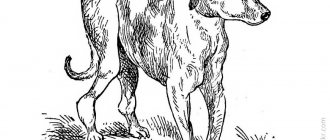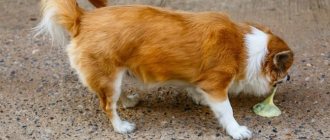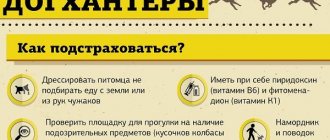Vomiting that occurs in a pet is a specific reflex. A normal eruption of gastric contents, one-time without any impurities, often indicates a long break between meals or, on the contrary, severe overeating.
It is possible for a dog to vomit once due to hormonal changes - during pregnancy. If blood is clearly visible in the vomit, then the animal’s health is at risk. Mandatory consultation with a specialist and the prescription of adequate therapy are necessary.
How to recognize blood in dog vomit
Nausea is a natural reaction of the body to an irritant. With a single eruption of yellowish vomit with partially digested pieces of food and a sour smell, there is no cause for concern. A different situation arises when blood appears. It is easily recognized by clots, streaks or inclusions that come out along with vomit. Their color varies from bright red to dark brown and even black.
If bloody impurities are detected, record their consistency and shade. This will help your veterinarian understand why your dog is vomiting blood. For a more accurate diagnosis, a sample of vomit will be useful. Place it in a clean container and take it with you to your appointment.
Typology of hematemesis
The causes of hematemesis depend on the appearance of the vomit. Read it carefully before going to the veterinary clinic.
Bright red hue of blood
A bright red tint is characteristic of uncoagulated blood that has not been exposed to gastric juice. This symptom occurs when there is mechanical damage to the oral cavity, pharynx or esophagus by a stuck object. Due to the discomfort that occurs, copious amounts of saliva are produced.
Dark clots
The appearance of dark clots indicates deeper damage. When internal bleeding occurs, a chemical reaction occurs with gastric juice, changing the color from bright red to brown. A sick dog is vomiting dark clots of coagulated blood.
With foam
The presence of foam is the result of another reaction. The reason for its appearance depends on the color. A bright red hue appears when the lung is damaged. Fresh blood turns into foam when mixed with air. The dark foam results from a reaction with the mucus that protects the stomach wall from acid.
With bile
Vomiting with bile is a characteristic symptom of damage to the gallbladder, liver, small intestine and pancreas. It is easily identified by its dark brown or dark green color, sharp and sour smell. This condition is accompanied by heavy bleeding due to a clotting disorder.
Other types
In addition to vomiting blood, your dog can also vomit other types of masses. Not all of them are dangerous. And some also indicate a serious illness:
- White foam most often indicates that the animal is simply very hungry. However, if this happens several times in a row, it indicates problems with the liver.
- Nausea immediately after eating, at best, indicates banal overeating, and at worst, the onset of gastritis. This happens after a fatty meal. In the most advanced cases, there may be blood streaks.
- Yellow bile masses appear during nausea if the liver is involved in the process. This happens with intestinal obstruction or active helminth activity.
Associated disorders
Depending on the cause, bloody vomiting in a dog is accompanied by a variety of associated disorders. These include
:
- diarrhea, discoloration of feces to black and the appearance of bloody spots;
- yellowing of mucous membranes and unusually bright shade of urine;
- frequent licking and refusal of water;
- increased excitability against the background of severe lethargy;
- decreased appetite and sudden weight loss;
- difficulty breathing and rapid pulse;
- temperature increase;
- dullness and hair loss;
- profuse drooling, belching, rumbling and abdominal pain;
- putrid or acetone smell from the mouth.
If you notice any of the above symptoms, take your dog to the vet. The earlier the diagnosis is made, the greater the chance of successful treatment without complications.
Probable causes of hematemesis
A possible cause can be suggested by the appearance of the vomiting and accompanying symptoms. The most common ones include
:
- Gastrointestinal infections
(enteritis, leptospirosis, hepatitis). When infected with viruses or other pathogenic microorganisms, fever and severe weakness are observed. Parvovirus enteritis, accompanied by acute diarrhea, is especially dangerous for puppies. If severe dehydration occurs, a small pet may die.
- Ulcerative
formations
. Thinning of the walls of the gastrointestinal tract, caused by poor diet or frequent infections, is fraught with the formation of bleeding ulcers. The disease is accompanied by alternating diarrhea and constipation. Bloody clots appear in the stool and vomit. - Oncological
diseases
. Bloody vomiting with cancerous tumors appears in the later stages. It is important to seek help as quickly as possible to prevent the development of metastases.
Internal organ
injuries caused by a foreign object entering the throat, stomach or intestines. Damage to the larynx is accompanied by wheezing and coughing, and injuries to the stomach are accompanied by acute pain.- Poisoning
by poisons
. Intoxication is accompanied by vivid and rapidly developing symptoms. The animal requires urgent hospitalization. - Acute
helminthiases
. If the dog has vomited adult parasites, larvae or eggs, then the cause of hematemesis is obvious. Worms can also be passed out in the feces. When intoxicated by helminth waste products, stool disturbances, abdominal pain, weakness and dulling of the coat are noted. In particularly severe cases, intestinal obstruction occurs. - Kidney
failure
. This condition is accompanied by an ammonia smell from the mouth.
The risk group includes animals with chronic diseases and pets taking non-steroidal anti-inflammatory drugs (Ibuprofen, Diclofenac). These medications reduce the number of platelets, which are responsible for the elasticity of blood vessels. As a result of thinning of the vascular walls, bleeding occurs.
Why is it dangerous?
If an adult dog or, especially, a puppy vomits blood, this is always fraught with death:
If the cause is a foreign body, it will either pierce the mucous membrane and peritonitis will begin, or it will injure the mucous membrane so much that internal bleeding will become very severe and lead to death.
If the cause is an infection, the body most likely will not cope with it and will literally burn out from the fever.
If the cause is poison, it usually takes from an hour to half a day from the appearance of bloody vomiting to death. The poison eats away internal organs. It is poorly treated even in a veterinary clinic.
If the cause is an ulcer, the dog will lose more and more weight, the ulcer will grow, and immunity will decline. Death will occur either from an infection that the weakened immune system cannot fight, or from the fact that most of the nutrients are no longer absorbed. But this is a long process; a dog can suffer from an ulcer even without treatment for several months.
If the cause is worms, the dog will live for several months, and maybe years. But nutrients will be poorly absorbed, the immune system will weaken and he will spend most of his time sleeping.
If the cause is cancer, metastases will spread throughout the body and within a year the dog will die from failure of one of the vital organs - or maybe several.
Vomiting blood is always very serious. Conditions that go away on their own do not cause it.
Helping your pet before seeing a veterinarian
Do not use antiemetic drugs. Vomiting removes toxins, so interrupting it will negatively affect the general condition of the patient.
To avoid infection, avoid contact with other pets. Stop feeding to reduce stress on your stomach. Drinking too much can cause more vomiting, so offer your dog an ice cube.
Be sure to call your veterinarian for advice on first aid medications. Self-selecting medications can be fatal. If it is impossible to urgently visit a veterinarian, it is recommended to give 1 tablet of Kvamatel. This drug reduces the amount of hydrochloric acid and reduces stress on the stomach.
In case of poisoning, only 2 hours are allotted for emergency assistance. If you don’t have time to get to the clinic, then proceed according to the following scheme:
- Introduce 3 percent hydrogen peroxide inside. The dosage is determined by weight: 1.5 ml per 1 kg.
- Give an activated carbon tablet. Repeat this procedure every 4 hours.
- Inject vitamin K1 (Phytomenadione) subcutaneously, an antidote for rat poison. For the first time, there should be 5 mg per 1 kg of weight, and after 12 hours – 1 mg.
Do not use folk remedies and take your dog to the vet as soon as possible. Remember that first aid for poisoning is not treatment. Only a doctor can save the animal.
When refusing food
Vomiting on an empty stomach may simply be a sign of hunger in your pet. But if the animal continues to refuse food, and bouts of vomiting continue, this can indicate anything: from poisoning with spoiled food to a serious illness. It is recommended not to force-feed the dog, and to take a twelve-hour break from feeding.
If your dog continues to refuse food and continues to vomit, contact your veterinarian. If this dog behavior is accompanied by a change in temperature and diarrhea, visit the veterinary clinic without waiting for changes in the animal’s well-being.
Diagnosis, treatment and prevention
Do not hesitate to contact the clinic. In case of damage to internal organs and poisoning by poisons, the clock counts.
Making a diagnosis in a veterinary clinic
To make a diagnosis, you will have to donate blood, urine and feces. Internal damage, foreign bodies and formations will be determined using x-rays and ultrasound. If an ulcer is suspected, an endoscopic examination cannot be avoided.
Surgery is suggested when a foreign object is detected or serious organ damage is detected. In other cases, taking medication is sufficient.
Drug therapy
Until vomiting is eliminated, the dog is placed in a hospital. Nutrients are administered through an IV; in severe cases, blood transfusion (blood transfusion) is recommended.
Drug therapy involves the use of antibiotics, anti-inflammatory drugs, antispasmodics, sorbents, antiemetics, anthelmintics and immunomodulators. In case of poisoning, the dog's stomach is washed and an antidote is administered.
To eliminate the ulcer, injections of pure medical alcohol are used. It cauterizes damaged mucous membranes and stops bleeding. To restore damaged tissue, a therapeutic diet is prescribed.
Diet and nursing
At the end of the starvation diet, the animal is transferred to a gentle diet. Usual portions are reduced, and the number of meals is increased. To restore the body, it is recommended to consume rice water, oatmeal and low-fat cottage cheese. When dry feeding, medicated feed is used, sometimes the granules are soaked.
Until recovery, the walking time is reduced to 10 minutes. Intense loads are excluded. If the dog lives in an outdoor enclosure, prepare a soft and warm place in the house and take him away.
Do not stop taking your medications once you feel better. Follow your doctor's advice and seek help if any alarming symptoms occur.
Therapeutic measures
For dogs, treatment begins immediately after an accurate diagnosis is made.
Treatment options include:
- Diet.
- Taking medications.
Antiemetics:
- Agents that enhance peristalsis. They affect the peristaltic processes in the digestive organs and help ensure that food moves further through the digestive system instead of returning back. Good for when your dog is vomiting. The most well-known peristalsis enhancer that can be given to a dog is Metoclopramide.
- Drugs that affect the vomiting centers in the brain. Their principle is based on the fact that they suppress the activity of the vomiting center of the brain and should neutralize the urge to vomit, so to speak, at the “highest level”. Such drugs that can be given to your pet include Serenia, Ondasetron.
To relieve pain, the dog is prescribed painkillers and antispasmodics - No-shpu or papeverine. To stop vomiting, cerucal comes to the rescue.
This medicine allows you to suppress the emetic effect and normalize the tone of the gastrointestinal tract. Cerucal has several forms of release - tablets and solution. The tablet is not effective and is excreted back into the vomit.
Injection cerucal is administered both intramuscularly and intravenously.
The drug is prescribed for medium and large animals. But cerucal has side effects. The side effect manifests itself in the form of lethargy and fatigue of the animal. If an animal has kidney failure, it is better to replace cerucal with another remedy.
If an animal's stomach is seething, then all the signs are signs of poisoning. Vomiting is the result of poisoning. The dog is prescribed phosphalugel.
The veterinarian has a universal remedy - phosphalugel. It removes toxins and viruses from the body, and dulls pain in the stomach.
The drug can be used both in pure form and in diluted form. Phosphalugel is a sorbent that reduces the percentage of poison absorption into the body.
To reduce the level of acidity in the stomach, the veterinarian prescribes omez, which helps improve appetite.
The doctor may prescribe different medications. There is no need to self-medicate, it will not lead to anything good, it will only bring harm.
The most popular is herbal decoctions. Mint, flaxseeds. The doctor will prescribe a fasting diet.
When the vomiting subsides, the dog is still weak. It is recommended to feed her with decoctions of the leaves. Buy food at the pet store and give it in small portions 2 times a day. The dog, of course, will refuse to eat at first; it is necessary to forcefully give food.
When the animal feels better, then they begin to feed more, but still in small portions, six times a day. Medicines irritate the mucous membrane of the pharynx and stomach.
Toxic-hematogenous, occurs due to the fact that metabolic products related to the toxic type accumulate in the body.
Toxins can be formed due to medications, due to some diseases. For example, diabetes, kidney failure, adrenal. Gaseous products can cause poisoning.
For example, carbon monoxide, chlorine, sulfonamides. The toxic group includes viral infections.
They accumulate a lot of toxins, harmful bacteria, they destroy every cell.
After vomiting, the dog should be put on a gentle diet. Treatment must be comprehensive, in addition to medications, the animal is prescribed a gentle diet.
The diet involves taking the following products:
- Low-fat cottage cheese.
- Boiled rice.
- Boiled meat, chicken, beef.
Why is this diet prescribed? It allows you to restore the functioning of the entire body. Gentle diet - in the first days, food is served in small portions, which gradually increase. After a few days, the usual diet takes effect.
The first day of transition is characterized by a 50/50 ratio. What does this mean? On the first day, the diet consists of half regular food and 50 diet food. On the second day, diet food consists of 75 percent regular food and 25 percent dietary food.
On the third day, the dog can be fed regular food.











